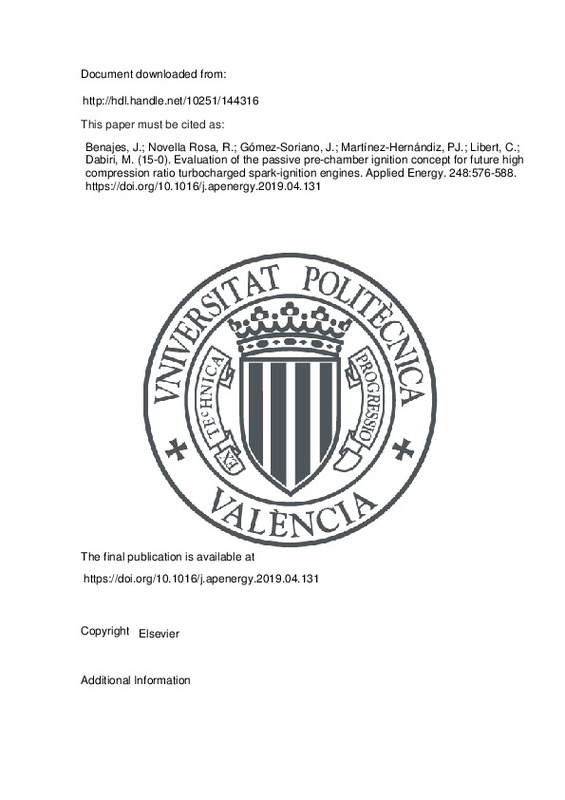JavaScript is disabled for your browser. Some features of this site may not work without it.
Buscar en RiuNet
Listar
Mi cuenta
Estadísticas
Ayuda RiuNet
Admin. UPV
Evaluation of the passive pre-chamber ignition concept for future high compression ratio turbocharged spark-ignition engines
Mostrar el registro sencillo del ítem
Ficheros en el ítem
| dc.contributor.author | Benajes, Jesús
|
es_ES |
| dc.contributor.author | Novella Rosa, Ricardo
|
es_ES |
| dc.contributor.author | Gómez-Soriano, Josep
|
es_ES |
| dc.contributor.author | Martínez-Hernándiz, Pablo José
|
es_ES |
| dc.contributor.author | Libert, C.
|
es_ES |
| dc.contributor.author | Dabiri, M.
|
es_ES |
| dc.date.accessioned | 2020-05-26T03:03:41Z | |
| dc.date.available | 2020-05-26T03:03:41Z | |
| dc.date.issued | 2019-08-15 | es_ES |
| dc.identifier.issn | 0306-2619 | es_ES |
| dc.identifier.uri | http://hdl.handle.net/10251/144316 | |
| dc.description.abstract | [EN] The pre-chamber ignition concept is an attractive strategy to enable the operation of spark-ignition engines in lean or diluted conditions keeping a suitable combustion process. According to the results the benefits in lean conditions include the combustion process shortening, the improvement of combustion stability and the increase of combustion efficiency by lowering carbon monoxide and hydrocarbons emissions. Thus, the pre-chamber ignition concept, especially in its passive version, arises as a promising alternative for future spark-ignition engines for passenger car applications. In this framework, an experimental investigation has been carried out to evaluate the potential of passive pre-chamber ignition concept in a high compression ratio, turbocharged, port fueled spark-ignition engine, using 95 Research Octane Number gasoline. As a first step, a 1D Wave Action Model was generated to design the pre-chamber geometry taking the fuel available at the start of pre-chamber combustion and the pressure difference between the main chamber and pre-chamber as key parameters. In a second step, these pre-chamber designs were experimentally validated at high load/speed conditions (4500¿rpm, 12.5¿bar Indicated Mean Effective Pressure) and compared with the conventional spark-ignition concept. Experimental results show how the passive pre-chamber concept increases efficiency with good combustion stability and high combustion efficiency in stoichiometric conditions. Nevertheless, maximum lambda attainable with the passive system is similar than that of the conventional spark and much lower compared to the maximum levels reported for the active system. | es_ES |
| dc.description.sponsorship | The work has been partially supported by the Spanish Ministerio de Economia y Competitividad through Grant No. TRA2017-89139-C2-1-R. | es_ES |
| dc.language | Inglés | es_ES |
| dc.publisher | Elsevier | es_ES |
| dc.relation.ispartof | Applied Energy | es_ES |
| dc.rights | Reserva de todos los derechos | es_ES |
| dc.subject | Spark-ignition engine | es_ES |
| dc.subject | Pre-chamber ignition | es_ES |
| dc.subject | Lean burn | es_ES |
| dc.subject | EGR dilution | es_ES |
| dc.subject | Efficiency and emissions | es_ES |
| dc.subject.classification | MAQUINAS Y MOTORES TERMICOS | es_ES |
| dc.title | Evaluation of the passive pre-chamber ignition concept for future high compression ratio turbocharged spark-ignition engines | es_ES |
| dc.type | Artículo | es_ES |
| dc.identifier.doi | 10.1016/j.apenergy.2019.04.131 | es_ES |
| dc.relation.projectID | info:eu-repo/grantAgreement/AEI/Plan Estatal de Investigación Científica y Técnica y de Innovación 2013-2016/TRA2017-89139-C2-1-R/ES/DESARROLLO DE MODELOS DE COMBUSTION Y EMISIONES HPC PARA EL ANALISIS DE PLANTAS PROPULSIVAS DE TRANSPORTE SOSTENIBLES/ | es_ES |
| dc.rights.accessRights | Abierto | es_ES |
| dc.contributor.affiliation | Universitat Politècnica de València. Departamento de Máquinas y Motores Térmicos - Departament de Màquines i Motors Tèrmics | es_ES |
| dc.description.bibliographicCitation | Benajes, J.; Novella Rosa, R.; Gómez-Soriano, J.; Martínez-Hernándiz, PJ.; Libert, C.; Dabiri, M. (2019). Evaluation of the passive pre-chamber ignition concept for future high compression ratio turbocharged spark-ignition engines. Applied Energy. 248:576-588. https://doi.org/10.1016/j.apenergy.2019.04.131 | es_ES |
| dc.description.accrualMethod | S | es_ES |
| dc.relation.publisherversion | https://doi.org/10.1016/j.apenergy.2019.04.131 | es_ES |
| dc.description.upvformatpinicio | 576 | es_ES |
| dc.description.upvformatpfin | 588 | es_ES |
| dc.type.version | info:eu-repo/semantics/publishedVersion | es_ES |
| dc.description.volume | 248 | es_ES |
| dc.relation.pasarela | S\387937 | es_ES |
| dc.contributor.funder | Agencia Estatal de Investigación | es_ES |







![[Cerrado]](/themes/UPV/images/candado.png)

